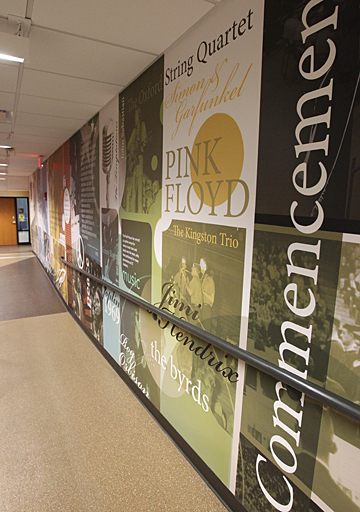
Concerts and sporting and political events are chronicled on a wall on the second floor of the Memorial Field House.
A new historic mural depicting the history of UT and the Memorial Field House stretches the length of the hallway on the second floor across from the auditorium entrance.
“This is the cherry on the sundae as far as completing the Field House goes,” said Michael Green, manager of mechanical engineering and energy for UT Facilities and Construction. “There is so much history here it’s unreal. It was a big decision to pick and choose what would make it onto the mural.”
The colorful wall is an artistic timeline of the history of the University and specifically the Field House. It includes large photos of historic campus events and quotes from famous visitors to the building.
Renovated in 2008, the building houses a state-of-the-art classroom center.
When it was completed in 1931, the Memorial Field House was the largest multipurpose facility on campus and was home to countless sporting events, concerts, political rallies and demonstrations, commencement activities and more.
“Believe it or not, the Field House actually had dirt floors when it was first built,” said Barbara Floyd, director of the Ward M. Canaday Center for Special Collections and university archivist. “When basketball games were held, they would replace the dirt with wooden slabs for the players to play on.”
In the 1950s, a permanent floor was installed.
“Under Coach Bob Nichols, the UT basketball team was the team of the city; they had fans packing the Field House every night,” Floyd said. “According to Coach Nichols, the fans were so close to the floor that you could almost feel the contact.”
Events like the first international wrestling meet made history at the Field House when athletes from the Soviet Union finally were allowed to come to the United States and compete.
Sporting events were not the only happenings that packed the Field House. Music legends Jimi Hendrix, Janis Joplin, The Temptations, Simon & Garfunkel, Roy Orbison, Kenny Rogers and many more rocked the building.
“Back then, the Field House was a key place that really brought in the entertainment,” Floyd said. “These artists were just performers at the time, but now they are today’s icons.”
In addition to sporting events and concerts, the Field House served as a political venue for then Vice President Richard Nixon’s visit Oct. 26, 1960, and the demonstration held by UT students in protest of the Kent State shootings in 1970.
“Memories are what the Field House is all about,” Floyd said. “The wall is a great way to honor the history we have here. Even though the original structure of the Field House still stands, the building can start to take on new meanings.”